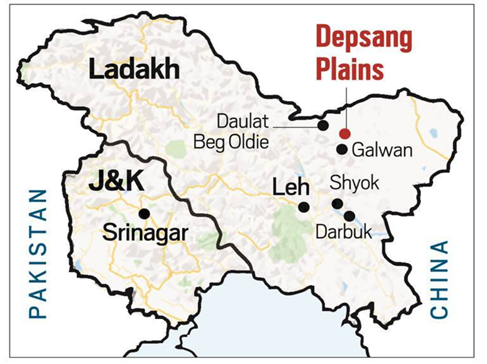

The Chushul sub-sector has come into focus in the standoff between the Indian and PLA troops.
Context
The Chushul sub-sector has come into focus in the standoff between the Indian and PLA troops.
Background
- Tensions along the disputed India-Chinaborder seem to be getting worse, three months after their deadliest confrontation in decades.
- The Asian giants accused each other this week of sending soldiers into the other's territory and fired warning shots for the first time in 45 years, raising the specter of full-scale military conflict.
- The high-altitude standoff along the eastern section of what's known as the Line of Actual Control (LAC), a loose demarcation, risks dramatically altering the already fraught relationship between the nuclear-armed neighbors.
- There are about 23 “disputed and sensitive areas” on the Line of Actual Control, stretching from Arunachal Pradesh to Ladakh region.
- The other sensitive areas in Ladakh include the Trig Heights, Dumchele, Chumar, Spanggur Gap and Pangong Tso.
- Outside of Ladakh, sensitive areas include Namkha Chu, Sumdorong Chu, Asaphila, Dichu, Yangtse, Fish Tail-I & II in Dibang Valley in Arunachal Pradesh and Barahoti, Kaurik & Shipki La in the middle sector.
Analysis
What is the Chushul sub-sector?
- The Chushul sub-sector lies south of Pangong Tsoin eastern Ladakh. It comprises-
- high, broken mountains and heights of Thatung
- Black Top
- Helmet Top
- Gurung Hill
- Magger Hill besides passes such as-
- Rezang La and Rechin La
- the Spanggur Gap
- the Chushul valley
- Situated at a height of over 13,000 feet close to the LAC, the Chushul Valley has a vital airstrip that played an important role even during the 1962 War with China.
- Due to its location, Chushul is one among the five Border Personnel Meeting points between the Indian Army and the People’s Liberation Army of China.
- It is here that representatives of the two armies meet for regular interactions.
- The recent brigade-level meetings between the two sides were also held here.
What is its strategic importance to India?
- Strategic location: Chushul enjoys tremendous strategic and tactical importance because of its location and terrain, which make it a centre for logistics deployment.
- Easy connectivity: This sector has plains that are a couple of kilometres wide, where mechanised forces, including tanks, can be deployed. Its airstrip and connectivity by road to Leh add to its operational advantages.
- Capability to dominate: Indian troops have now secured the ridgeline in this sub-sector that allows them to dominate the Chushul bowl on the Indian side, and Moldo sector on the Chinese side.
- Clear sight: They also have a clear sight of the almost 2-km-wide Spanggur gap, which the Chinese used in the past to launch attacks on this sector in the 1962 War.

Did the Chinese try to capture Chushul in the 1962 War?
- After the initial attacks, including on the Galwan valley by the Chinese in October 1962, the PLA troops prepared to attack Chushul airfield and the valley to get direct access to Leh.
- However, just before the attacks were launched, the area was reinforced by the 114 Brigade in November 1962, which also had under its command two troops of armour and some artillery.
- It’s important to note that the heights secured by Indian soldiers on the intervening night of August 29-30 were held by them in 1962 as well. These included Lukung, Spanggur Gap, Gurung Hill, Rezang La, Magger Hill and Thatung Heights.
- The units which held these areas included the 5 Jat, 1 Jat, 1/8 Gorkha Rifles, and 13 Kumaon. The Indian soldiers gave an outstanding account of themselves in the battles, where famously at Rezang La, the Charlie Company of 13 Kumaon lost 114 soldiers out of its total 120. The Company Commander, Maj Shaitan Singh, was awarded the Param Vir Chakra for gallantry posthumously.
- After Gurung Hill and Rezang La fell to the Chinese, the brigade pulled back troops to the heights to give a better response to the enemy. However, the anticipated next attacks never came, as a ceasefire was declared. The brigade achieved its primary task after suffering 140 casualties, while the Chinese lost more than 1,000 soldiers.
Challenges in this area
- An immediate challenge is of a flare-up as troops of the two countries are deployed within a distance of 800 to 1,000 metres of each other at Black Top and Rechin La.
- Logistics also pose a major challenge. At this point, villagers of Chushul are being of great help.
- Chushul village in Durbuk tehsil is home to around 170 families, most of whom are of Tibetan descent.
- The villagers have been ferrying water and essential commodities to the Indian troops deployed at Black Top.
Conclusion
India and China inherited their territorial disputes from the period of British colonial rule. Border tensions have persisted despite talks at military, diplomatic and political levels. With strong nationalists leading both countries, the border has taken on a prominence not seen in years. Experts warn that if military hostilities are not stopped, war could be next.


